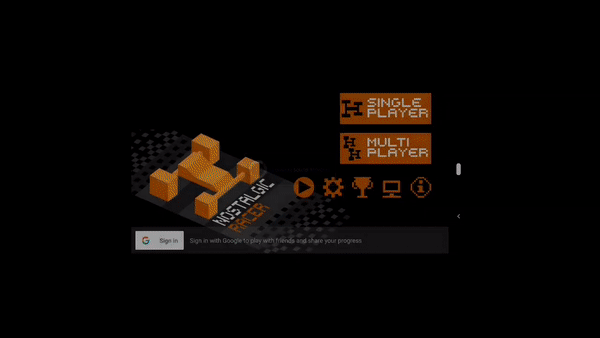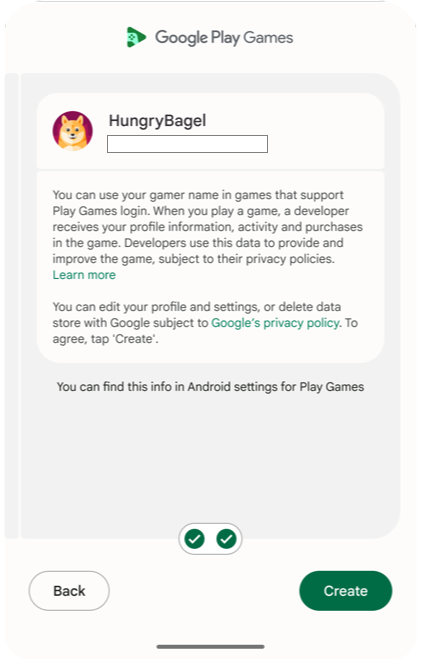如需将游戏与 Google Play 游戏服务集成,请先实现平台身份验证。这是访问所有其他功能(例如成就、排行榜和活动)的必要条件。
为了满足 Google Play Games Level Up 用户体验指南,您的游戏需要符合推荐的身份验证流程。
初始化和身份验证
这是初始化和验证游戏的必要步骤:
- 通过在启动时初始化 Play 游戏服务 v2 SDK 来实现平台身份验证。如需了解详情,请参阅 Android 游戏的平台身份验证。 这是访问成就和排行榜等 Play 游戏服务功能的必要步骤。
- 身份验证在游戏启动期间作为静默后台进程运行。
现有 Play 游戏服务用户在成功通过身份验证后会看到一条欢迎消息。

创建个人资料
玩家需要拥有 Play 游戏服务玩家资料才能使用该平台。有些玩家在开始玩您的游戏时可能没有 Play 游戏服务个人资料。系统会要求这些玩家创建角色。
默认情况下,当您启动没有 Play 游戏服务玩家资料的游戏时,系统会自动显示自动触发的玩家资料创建提示。

建议的身份验证流程
为符合 Google Play Games Level Up 用户体验指南的要求,请验证您是否符合玩家连续性要求。若要让玩家成功登录游戏,请使用以下身份验证流程:
- 在游戏启动过程中,实现自动触发的玩家资料创建。
- 如果自动身份验证失败或您拒绝,请显示手动登录按钮,以便您稍后进行身份验证。
玩家 ID
玩家 ID 是 Play 游戏服务玩家账号的标识符。您的游戏可以检索使用 Play Games 服务身份验证登录游戏的任何玩家的玩家 ID。您的游戏客户端集成、游戏服务器集成和云端存档服务可以使用玩家 ID 安全地访问 Play 游戏服务中的玩家数据。
当用户在多个设备上玩同一款游戏时,玩家 ID 是一致的。但是,不同游戏之间不一定会始终保持一致。 如需了解详情,请参阅新一代玩家 ID。
OAuth 范围
Play 游戏服务依赖 OAuth 系统来允许玩家授权您的游戏访问他们的账号。Play 游戏服务针对游戏提供唯一范围 (games-lite),如果您的游戏使用游戏存档功能,将依赖另一个范围 (drive.appdata)。通过游戏存档功能,您可以访问用户的 Google 云端硬盘账号,游戏数据便存储在此处。
使用 Play 游戏服务 v2 SDK 时,您可以请求额外的 OAuth 范围。如果您需要额外的 OAuth 范围,建议您调用 requestServerSideAccess。如需了解详情,请参阅获取服务器授权代码或检索服务器身份验证代码。
多种身份验证服务
Play 游戏服务为 Android 玩家提供游戏身份,但此身份不一定是与用户关联的唯一身份。您可以同时使用 Play 游戏服务、社交网络 ID 和您自己的游戏内 ID 系统为玩家提供身份验证。
Recall API
借助 Recall API,游戏可以将 Recall 令牌存储在 Google 服务器中,从而管理 PGS 用户与其游戏内账号之间的关联。如需详细了解如何启用此功能,请参阅在游戏中集成 PGS Recall API。
游戏客户端集成
将身份验证功能集成到游戏项目中时,我们建议您遵循以下用户流:
在游戏启动过程中,个人资料创建会启动并尝试验证用户身份或创建新账号。
如果自动身份验证失败或您拒绝身份验证,系统会显示手动登录按钮,以便您稍后进行身份验证。
如需了解如何在游戏项目中集成身份验证,请参阅适用于您的项目类型的文档:
游戏服务器集成
验证玩家已通过身份验证后,您可以调用 requestServerSideAccess 获取服务器授权代码。将此服务器授权代码传递给您的后端游戏服务器,以便直接与 Play 游戏服务服务器通信。通过这种通信,您的服务器可以访问玩家数据,包括:
- 玩家 ID
- 个人资料
- 朋友列表
- 游戏进度
- 成就
然后,您的服务器会使用此授权代码与 REST API 安全地与 Play 游戏服务服务器互动。 如需了解详情,请参阅 Play 游戏服务的服务器端访问。
登录请求配额
Play 游戏服务的登录请求存在每日配额。如需了解详情,请参阅管理每日配额。
